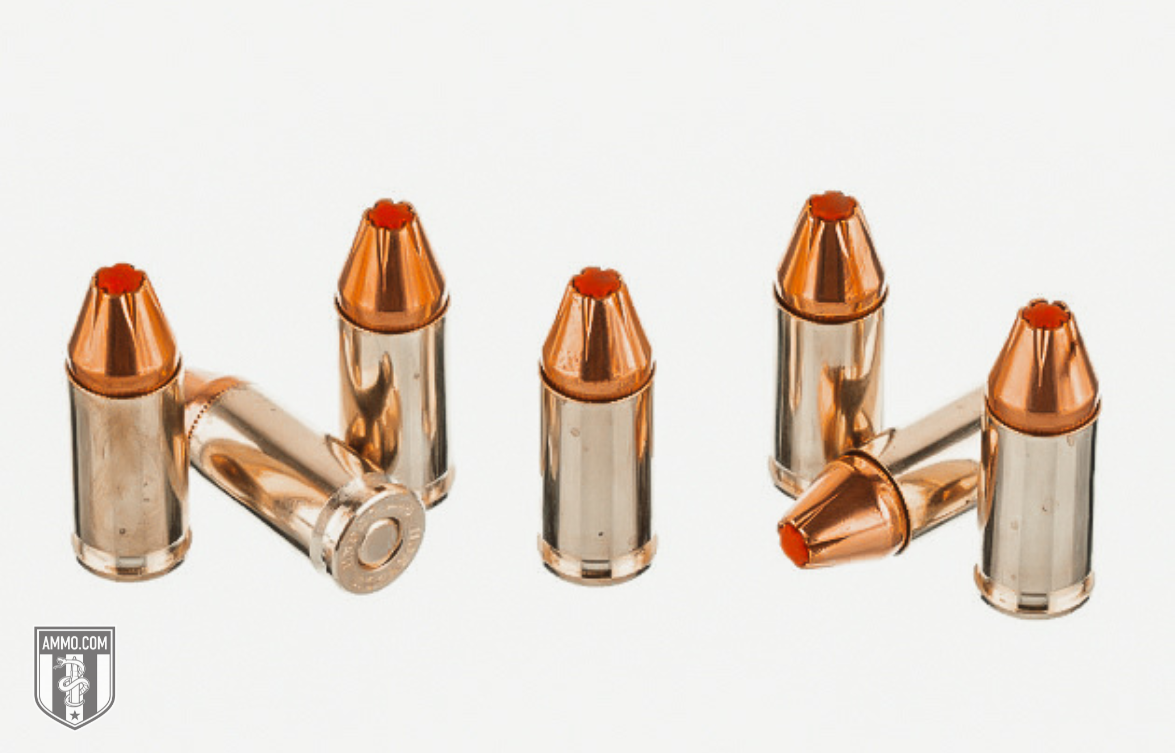.50 AE vs. 9mm: Power or Precision?
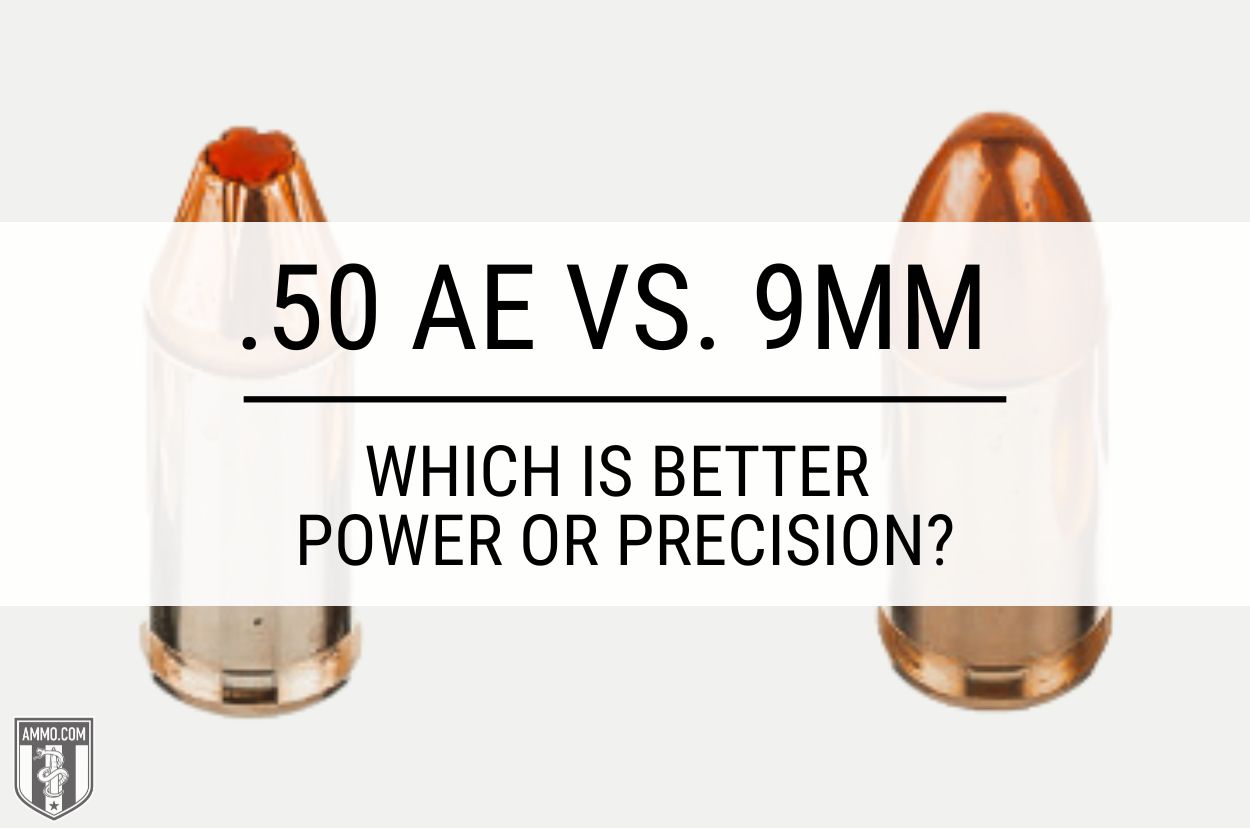 50 AE vs. 9mm is a comparison between vastly different pistol cartridges. One is perfect for concealed carriers, and the other is a must for big game hunters.
50 AE vs. 9mm is a comparison between vastly different pistol cartridges. One is perfect for concealed carriers, and the other is a must for big game hunters.
Any round has its unique advantages and disadvantages. As you continue reading, you’ll discover the relative pros and cons of these two handgun cartridges in everyday scenarios. We’ll track which is better in certain situations and tally the score at the end of the article to determine a winner.
Let’s go!
.50 AE Compared To 9mm
The .50 Action Express is one of the most powerful handgun cartridges in production, with some .50 AE ammo generating more than 1,660 ft-lbs of muzzle energy. The Magnum Research Desert Eagle 50 AE is one of Hollywood’s favorite guns, regularly seen in movies such as Snatch and The Matrix. The .50 AE is also a popular choice for big game hunting worldwide.
The 9mm Luger is one of the most popular concealed carry choices because of its low recoil and high magazine capacity. It’s chambered in pistols (such as the Glock 17), revolvers such as the Ruger LCR, and carbines such as the Smith & Wesson M&P FPC.
We’ll begin our comparison with each cartridge's technical specifications and then explore real-world scenarios to help you determine which cartridge is better.
Technical Specs: 9mm vs. .50 AE
When we compare these cartridges side by side, the differences are clearly visible. Shooters will have no problem distinguishing between the 9mm Luger (1.169 inches in total length) and .50 Action Express (1.610 inches in total length).
For starters, the .50 AE is loaded with a .50 caliber bullet (0.5 inches in diameter), which is even larger than 44 Magnum and 454 Casull bullets. The 9mm fires a much smaller projectile (0.355 inches), which is narrower than a 40 S&W bullet. Its larger diameter also means the .50 AE has a much heavier bullet weight (300 grain bullets are the most common) than the 9mm (165 grain is one of the heaviest).
Just because the .50 AE utilizes a heavier projectile doesn’t mean it has a slow muzzle velocity; the opposite is true. Thanks to its high case capacity (47.2 grains), it can hold more propellant to launch the bullet at a high velocity (1,450+ fps). The 9mm only has a case capacity of 13.3 grains, and conventional standard pressure factory ammo maxes out muzzle velocities at around 1,300 fps.
The most surprising similarity for me was the maximum pressure. The .50 AE maxes out at 36,000 psi, and the 9mm maxes at 35,000 psi.
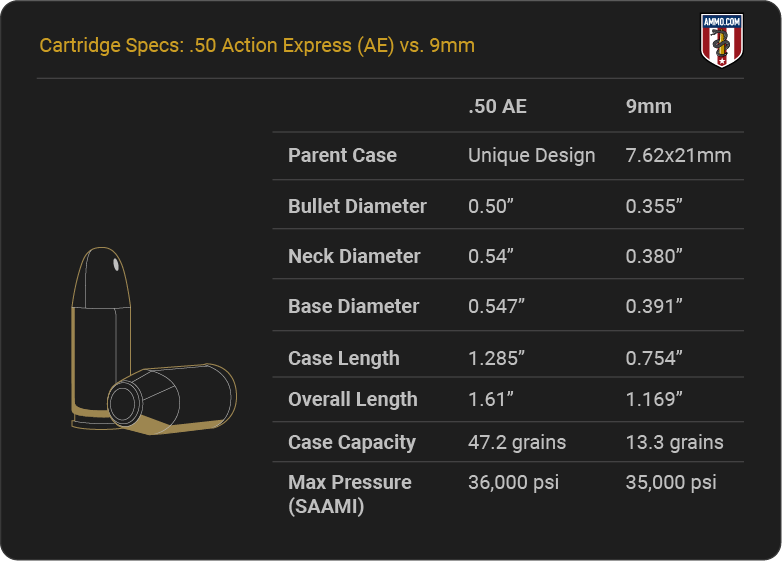
Before you purchase either cartridge, let’s examine how these differences and similarities affect recoil, accuracy, stopping power, overall cost, and other significant factors.
What Is the Recoil Like on a .50 AE Compared to a 9mm Pistol?
Recoil is an essential consideration. A round with lots of recoil is more challenging to control, slows your follow-up shot rate, and causes flinching to become more of an issue.
Free recoil is determined by muzzle velocity (fps), propellant weight, bullet weight, and firearm weight. Felt recoil differs from shooter to shooter and often depends on the firearm, stance, and ammo. Felt recoil is subjective. I will judge based on free recoil because it’s objective.
It’s impossible to provide an “apples to apples” comparison of both cartridges because of the drastic differences in gun weight, bullet weight, and propellant load. However, I’ll do my best to make everything as fair and straightforward as possible.
We’ll use a Magnum Research Desert Eagle .50 Action Express, which weighs 4.8 pounds and is loaded with an Underwood Ammo 325 grain jacketed hollow point (JHP) cartridge with a muzzle velocity of 1,475 fps.
The .50 AE will have around 27 ft-lbs of recoil in the given scenario. That’s a lot for a handgun.
For the 9mm, we’ll use the Glock 45, which weighs 2 pounds and is loaded with Winchester 115 grain full metal jacket (FMJ) ammo with a muzzle velocity of 1,190 fps. In this scenario, the 9mm will only have around 4 ft-lbs of free recoil.
The 9mm easily wins this section as the .50 AE has abundantly more recoil than the 9mm.
Trajectory: .50 Action Express vs. 9mm Parabellum
Pistol cartridges don’t typically have a good trajectory. Their range tends to be within 25 yards, so trajectory is much less of a factor.
However, since the .50 AE is commonly used for hunting, I thought it was important to mention that it’s a flat-shooting handgun cartridge within 200 yards. The 9mm simply cannot match the trajectory of the .50 AE.
The .50 AE wins this section.
Accuracy: 9x19mm vs. .50 AE
A round's accuracy depends on many factors: the shooter, firearm, ammo selection, and environmental conditions must all be considered. This means it’s virtually impossible to have a fair comparison. However, recoil and trajectory also help determine a cartridge's accuracy.
Since the 9mm has lower recoil, many shooters will find it more accurate, especially at close range (i.e. within 25 yards). Long-distance handgun shooters (50+ yards) will find the .50 AE more precise because of its flatter trajectory.
This section is a draw.
Stopping Power: .50 AE vs. 9mm Luger
No matter how you measure it, the .50 AE is more powerful and has more stopping power than the 9mm.
The best argument that trumps stopping power is shot placement. A hit to the foot with a .50 AE won’t end the threat as quickly as a 9mm to center mass. This is another reason why accuracy is crucial.
Strictly regarding stopping power, the .50 Action Express hand cannon wins this section.
Hunting: 9mm NATO vs. .50 Action Express

Since the 9mm is rarely used for hunting – and the .50 AE is most often used for hunting – we can all agree the .50 AE will provide more hunting opportunities because you can take big game from farther distances, thanks to the increased kinetic energy of the .50 AE.
Depending on a couple of factors, including bullet weight (lighter projectiles maintain less energy down range), the 9mm will only have around 250 ft-lbs of energy at 100 yards. In contrast, the .50 AE will have over 1,000 to 1,200 ft-lbs at 100 yards.
This allows you to ethically harvest game animals at greater distances with the .50 AE.
The .50 AE wins this section.
Self-Defense: .50 AE vs. 9mm
Power isn’t everything when it comes to personal protection. Whether you need a round for home defense or concealed carry, the best option is to use the firearm and ammo you’re comfortable with.
For most shooters concerned with personal protection, a 9mm should be their top pick (when choosing between the .50 AE and 9mm).
A 9mm is the better self-defense cartridge because it’s less likely to over-penetrate, easier to control, and more accurate. Guns and ammo are also reasonably inexpensive and easy to find. Beretta, Colt, Glock, Springfield Armory, Smith & Wesson, and countless other firearms manufacturers make pistols designed for concealed carry and self-defense chambered in 9mm.
The 9mm easily wins this section.
Ammo & Firearm Cost & Availability
We’ve briefly touched on this, so I won’t beat it to death. 9mm ammo and firearms are less expensive than .50 AE ammo and guns.
While Hornady and a few other major ammo manufacturers make .50 AE ammo, the selection is severely limited compared to 9mm options. The same goes for firearms.
The .50 AE is a niche firearm, so it’s not readily available like the ever-popular 9mm.
The 9mm wins this section.
Reloading
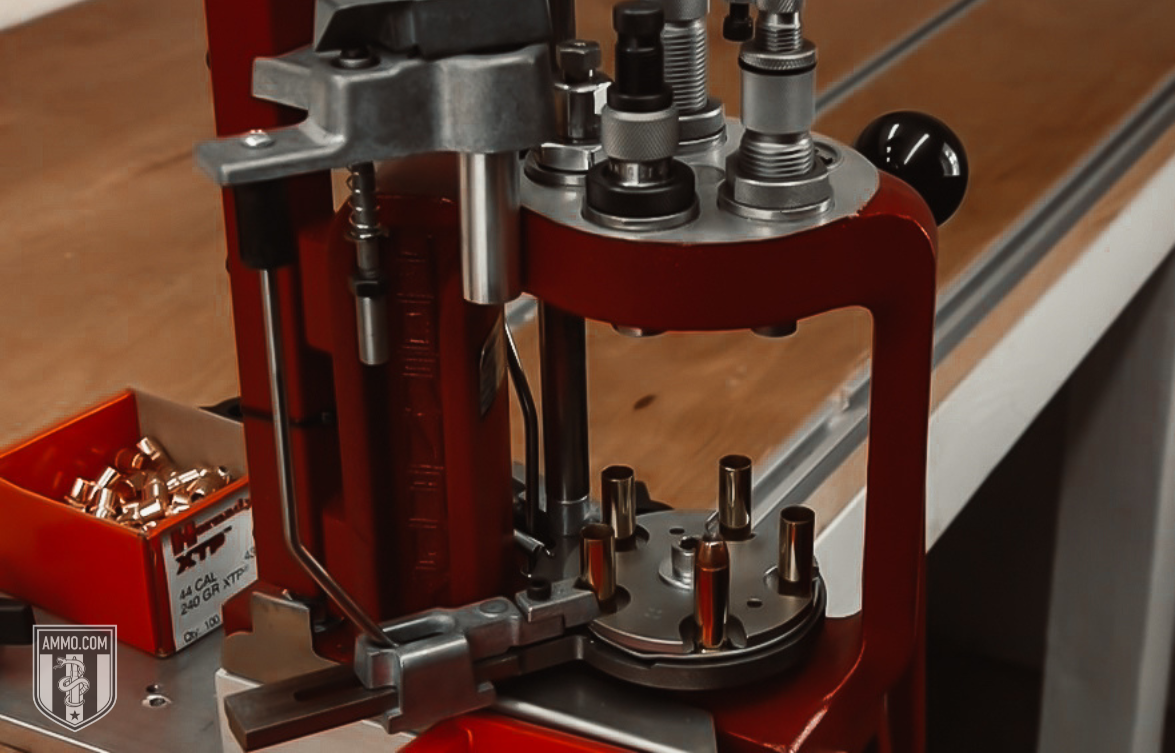
Both cartridges can be reloaded or handloaded. Materials and information are abundant on reloading 9mm or .50 AE.
Because the 9mm is the more popular round, more information and supplies are available. However, this is not a significant reason to sway the win in its favor.
This section is a draw because both cartridges can be reloaded.
Ballistics: 9mm vs. .50 Action Express
Here’s a section for all the numbers nerds. We’ll briefly discuss the ballistic capabilities of each cartridge, but you can always take it further by clicking on the links to our in-depth ballistics articles.
Note: This information comes from ammo manufacturers. The actual ballistics obtained with your firearm can vary considerably from the advertised ballistics. Also, ballistics can vary from lot to lot with the same brand and type load.
.50 AE Ballistics
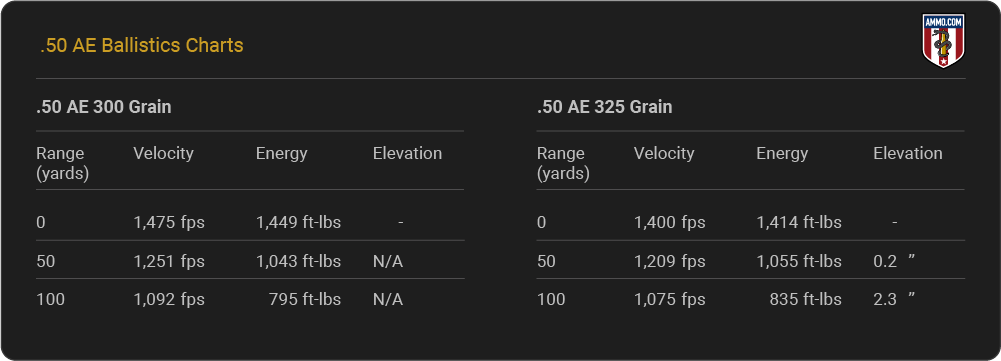
9mm Ballistics

Don’t miss the deep dive into the 9mm ballistics of every major manufacturer.
.50 Action Express Brief History
American cartridge designer Evan Whildin developed the .50 Action Express in 1988. It’s a large-caliber handgun cartridge often found in firearms such as the Desert Eagle, AMT AutoMag V, LAR Grizzly Win Mag, and Magnum Research BFR.
Today, it’s primarily a metallic silhouette shooting and hunting cartridge. It is excellent for bear defense.
9mm Luger Brief History
Georg Luger designed the 9mm cartridge in 1901. Though it got off to a relatively slow start in America (the U.S. Army overlooked it for the 45 ACP), it eventually became one of the most popular cartridges worldwide.
Today, it’s primarily used for shooting competitions, concealed carry, home defense, and regular old plinking at the range.
Parting Shots
Now that you’ve read this .50 AE vs. 9mm article, it’s time to tally the results.
The .50 AE won three sections. Two sections were a draw. The 9mm won three! It’s ultimately a tie, but we will have a true winner since this isn't soccer.
The 9mm is the better choice for those looking for a fun target shooting and defense cartridge.
For the shooters and hunters looking to take down big game, whether in Africa or North America, the .50 AE is the way to go.
No matter which cartridge you choose, don’t miss all the ammo deals we have here at Ammo.com!
Ammo Comparisons
- .308 vs 5.56
- 6.5 Creedmoor vs .308
- .300 Blackout vs .308
- .300 Win Mag vs .308
- .243 vs .308
- .308 vs .30-06
- 7mm-08 vs .308
- .270 vs .308
- 7.62x39 vs .308
- .223 vs .308
- .338 Lapua vs .308
- .380 ACP vs 9mm
- .223 vs 5.56
- .300 Blackout vs 5.56
- 9mm vs 45 ACP
- 9mm vs 40 S&W
- .357 SIG vs 9mm
- 10mm vs 9mm
- 9mm vs 9mm Luger
- .243 vs .270
- .300 Win Mag vs .30-06
- .270 vs .30-06
- .40 vs .45
- 38 Special vs 357
- 9mm vs 40 vs 45
- 5.56 vs 7.62x39
- 338 Lapua vs .30-06
- .30-30 vs .30-06
- 300 PRC vs 338 Lapua
- .30-06 vs 7mm
- 300 Win Mag vs 338 Lapua
- 300 PRC vs 300 Win Mag
- 300 WSM vs 300 Win Mag
- 338 Win Mag vs 338 Lapua
- 12 Gauge vs 20 Gauge
- 10mm vs 357 Mag
- .30-30 vs 7.62x39
- 224 Valkyrie vs 22-250
- 17 HMR vs 22 Mag
- 7.62x39 vs .300 Blackout
- 45 ACP vs 45 Auto
- 45-70 vs 30-30
- 300 Blackout vs 223
- 357 Magnum vs 9mm
- 350 Legend vs 300 Blackout
- 224 Valkyrie vs 223
- 45 ACP vs 38 Super
- 6.5 Grendel vs .308
- 17 HMR vs 22 LR
- 10 Gauge vs 12 Gauge
- 22-250 vs 223
- 45 Colt vs 45 ACP
- 350 Legend vs 30-30
- 5.7x28 vs 223
- 5.7 vs 9mm
- 5.56 vs 5.7
- 22 vs 9mm
- Buckshot vs Birdshot
- 450 Bushmaster vs 308
- 450 Bushmaster vs 223
- Buckshot vs Slug
- 6.5 Grendel vs 5.56 vs 223
- 6mm ARC vs 6.5 Grendel
- 44 vs 45
- 458 SOCOM vs 5.56
- 357 vs 44
- 32 ACP vs 380
- 300 Win Mag vs 338 Win Mag vs 338 Lapua Mag
- 450 Bushmaster vs 458 SOCOM vs 50 Beowulf
- 6mm Creedmoor vs 6.5 Creedmoor
- TMJ vs FMJ
- 44 Special Vs 44 Magnum
- 45 90 vs 45 70
- 6.8 Western vs 6.8 SPC
- 50 Beowulf vs 50 BMG
- 26 Nosler vs 6.5 PRC
- 28 Gauge vs 410
- 6.8 SPC vs 5.56
- 6.8 SPC vs 6.5 Grendel
- 6.8 Western vs 7mm Rem Mag vs .28 Nosler
- 6.8 Western vs 6.5 Creedmoor
- 22 Hornet vs 223
- 6.8 Western vs 6.5 PRC
- .410 vs 12 Gauge
- .410 vs 20 Gauge
- 22 LR vs 22 Mag
- 6mm ARC vs 243
- 7mm-08 vs 270
- 243 vs 6.5 Creedmoor
- Nickel vs Brass Casing
- 204 Ruger vs 223
- 50 Beowulf vs 5.56
- 260 Remington vs 6.5 Creedmoor
- 6mm Remington vs 243
- 28 Nosler vs 300 PRC
- 50 Beowulf vs 50 AE
- 22 Nosler vs 22-250
- 450 Marlin vs 45-70
- 300 Win Mag vs 300 Norma
- 458 SOCOM vs 300 Blackout
- 38-55 vs 45-70
- 22 Hornet vs 22 LR
- 300 Norma vs 338 Lapua
- 338 Lapua vs 50 BMG
- 28 Nosler vs 300 Win Mag
- 28 Nosler vs 6.5 Creedmoor
- 204 vs 22-250
- 458 SOCOM vs 45 70
- 44 40 vs 45 70
- 6.8 SPC vs 6.5 Creedmoor
- 450 Bushmaster vs 30-06
- 7mm Rem Mag vs 300 Win Mag
- 30 Carbine vs 223
- 25-06 vs 30-06
- 26 Nosler vs 28 Nosler
- 16ga vs 12ga
- 30 06 vs 7.62 x54R
- 9mm Makarov vs 9mm Luger
- 350 Legend vs 223
- 30 Carbine vs 5.56
- 6.5x55 vs 6.5 Creedmoor
- 6.5 Creedmoor vs 270 vs 25-06
- M193 vs M855
- 450 Bushmaster vs 458 SOCOM
- 6.5 Grendel vs 6.5 Creedmoor
- 350 Legend vs 5.56
- .277 Fury vs 6.8 SPC
- 277 Fury vs 300 Win Mag
- 10mm vs .45 ACP
- 277 Fury vs 223
- 6.8 SPC vs 300 Blackout
- 6.5 PRC vs 6.5 Creedmoor
- 277 Fury vs 308
- 277 Fury vs 6.5 Creedmoor
- 350 Legend vs 450 Bushmaster
- 277 Fury Vs 5.56 NATO
- 10mm vs 40S&W
- 32 ACP vs 9mm
- 32 Special vs 9mm
- 8.6 Blackout vs 300 Blackout
- 30 Super Carry vs. 9mm
- 5.56 vs 9mm
- .50 Action Express vs 9mm
- 7.62x25 vs. 9mm
- 10mm vs 44 Magnum
- 300 Blackout vs 300 Win Mag
- 6.5 Grendel vs 300 Blackout
- 460 Rowland vs 10mm
- 300 RUM vs 300 PRC
- 300 Norma vs 300 PRC
- 45 GAP vs 45 ACP
- 7mm PRC vs 300 Win Mag
- 300 PRC vs 6.5 Creedmoor
- 300 PRC vs 308
- 357 SIG vs 357 Mag
- 7.62x39 vs 7.62x51
- 243 Win vs 223 Rem
- 30 Nosler vs 300 PRC
- 6.5 Creedmoor vs. 30-06 Springfield
- 450 S&W vs. 44 Magnum
- 6.5 Creedmoor vs. 300 Win Mag
- 454 Cassull vs. 45-70 Govt
- 454 Cassull vs. 44 Mag
- 7.62x54r vs. 308 Winchester
- 22 ARC vs. 223 Rem
- Subsonic vs. Supersonic Ammo

